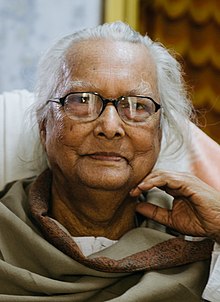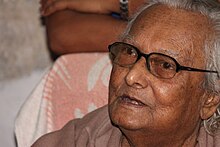Narayan Debnath
| Narayan Debnath | |
|---|---|
 Debnath in 2013 | |
| Born | 1925 (Shibpur)Howrah,Bengal Presidency,British Raj |
| Died | 18 January 2022(aged 96) Kolkata,West Bengal,India |
| Nationality | Indian |
| Area(s) | West Bengal,India |
Notable works | Bantul the Great,Handa Bhonda,Nonte Fonte |
| Awards | President's Special Recognition Award (2007),Sahitya Akademi(2013),Banga Bibhushan(2013),D. Litt.byRabindra Bharati University(2015), |
| Spouse(s) | Tara Debnath |
| Children | 2 |
Narayan Debnath(25 November 1925 – 18 January 2022) was an Indiancomics artist,writerandillustrator.[1]He created theBengalicomic stripsHanda Bhonda(1962),Bantul the Great(1965) andNonte Phonte(1969). He holds the record of longest running comics by an individual artiste forHanda Bhondacomics series which completed its continuous 53 years of running. He was the first and only comics artist in India who has received aD. Litt.degree.[2]Debnath was awardedPadma Shri,the fourth highest civilian award in India, in the year 2021.[3]
His other creations likeRabi Chobiwas published to celebrate the birth centenary ofRabindranath Tagorein the May 1961 issue of the weekly magazine calledAnandamela.The full length 50-page comics were first published in the book format bySarvodaya Sahitya Prakashan,Varanasi.Rajar Raja(was published in 1962), it was illustrated by Narayan Debnath and written by Bimal Ghosh to celebrate the birth centenary ofSwami Vivekananda.
Early life[edit]

Narayan Debnath was born and spent most of his life living inShibpur,Howrah,India. His family hailed fromBikrampurin what is nowBangladeshbut had migrated toShibpurbefore his birth. In an interview published by Laalmati Publication inNarayan Debnath Comics Samagra,Debnath confessed that he was interested in visual arts from a very early age. The family business was retailing gold and he had ample scope to design patterns for jewellery. During the time ofWorld War II,Debnath would studyfine artsat the Indian Art College for five years. He did not continue to get his degree but instead discontinued in his final year.[4]For the next few years he freelanced for advertising agencies creating movie slides and logos. Debnath recounts inNarayan Debnath Comics Samagra, Vol. 2that on the day of his weddingGandhiwas assassinated, which caused much inconvenience to the guests. The four volumes ofNarayan Debnath Comics Samagraprovide rich information about the life of the author.[5]
In 1950 he was introduced to Dev Sahitya Kutir, a major publishing house through a friend. People such as Pratul Chandra Banerjee, Shailo Chakraborty, Balaibandhu Roy, and Purnachandra Chakraborti were associated with the press at the time. From 1950 to 1961 he illustrated a number of children's books including adventure novels and Western classics in translation. His journey in comics started in 1962 with 'Handa-Bhonda' inShuktara.[6]
He began as a freelancing comics-artist and soon went for comics on his own. However, when still a struggling freelancer, he was instructed by the publisher to adopt 'well accepted foreign comics' to make comics for their magazine(s) to get easy business.
Introduction to comics[edit]
His works in comics inBengalicame from the editors at Dev Sahitya Kutir. Also the name 'Handa Bhonda' was their suggestion. Debnath had been familiar with foreign comics, but comics in Bengal, to his belief, had yet to take off. 'Shiyal Pandit', a comic strip created by Pratul Chandra Lahiri for theJugantarnewspaper was one of the earliest ones.Handa-Bhondabecame an instant success and continues to be printed inShuktaraevery month.Handa-Bhondawas initially penciled and inked by Debnath and had no coloured frames. Later it would be printed in the grey-scale.[7]
Narayan Debnath's first comic characters in color were for the comic strip and book 'Bantul The Great'. By Debnath's admission, he thought up the idea of the superhero while returning fromCollege Street, Calcutta.The name came to him instantly and he thought up the figure of the protagonist rapidly.Batul the Great,written and illustrated with red and black ink made his first appearance in comic strips in the May–June (Bengali Baishak), 1965 issue of the monthly children's periodical called Shuktara, published by Dev Sahitya Kutir (henceforth DSK) publishing house. This character has similarities withDesperate Dan.Apart fromBatul the Great,Debnath also illustratedRabi Chobi(1961), written by Bimal Ghosh about the childhood days of Rabindranath Tagore. HisRajar Raja/Chobite Vivekananda(1962) recreates the life and times of Swami Vivekananda, while hisChitre Durgeshnandini(1962) re-imagines Bankimchandra Chattopadhyay's novelDurgeshnandiniin graphic novel techniques. But it was hisHanda Bhoda(1962),Nonte Phonte(1969) andShootki ar Mootki(1964) that revolutionized the comic genre in Bengal through the familiar trope of the ‘terrible twins’ at boarding school. This trope could be traced back to the German artist Wilhelm Bosch'sMax and Moritz(1865) – an illustrated story in verse, which later found its way into the English world asThe Katzenjammer Kids(1897) of Rudolph Dirks and Harold H. Knerr. The trope is also found in Hergè'sQuick and Flupke(1930).
Development of the genre[edit]

When theBangladesh War of Liberationflared up, he was asked by the editors and publishers to add an aura of invincibility. He made Bantul a superhero able to take on tanks, aircraft, and missiles. Bullets began to bounce off of him. Bantul was still drawn by Debnath forShuktara.
He gave birth to eponymous cartoon characters, Nonte and Phonte in 1969, and since then, stories revolve around them, have been regularly published in “Kishor Bharati”.[8]
He had started his freelancing artist career from 1950 in Shuktara magazine and did the record of doing highest number of illustrations in Bengal. He was a renowned illustrator during his time. His work forTarzanstories (continuous for 42 years), Bengali translation of foreign novels etc. are among his great works of illustration.[9]
Personal life and death[edit]
Narayan Debnath was admitted to a hospital on 24 December[10]and died of heart related ailments on 18 January 2022 inKolkata,at the age of 97.[11][12][13][14]
Selected creations (Chronological List)[edit]
- Rabi-Chhabialso spelled asRabi Chobi[রবি-ছবি] (Comics; First published in 1961; republished in 2010)
- Rajar Raja/Chhabite Vivekananda[রাজার রাজা/ছবিতে বিবেকানন্দ] (Comics; First published in 1962)
- Chitre Durgeshnandini[চিত্রে দুর্গেশনন্দিনী] (Graphic novel; First published in 1962)
- Handa Bhonda,also referred to asHada Bhoda,Handa-BhondaandHada-Bhoda[হাঁদা-ভোঁদা] (First published in 1962)
- Sutki-Mutki[শুটকি-মুটকি] (First published in 1964)
- Chhatrapati Shivaji[ছত্রপতি শিবাজী] (Comics; Published from 1964 to 1965)
- Batul The Great,also referred to asBantul The Great[বাঁটুল দি গ্রেট] (First published in 1965)
- Hirer Tayra[হীরের টায়রা] (First published in 1965)
- Nonte Phonte,also spelled asNonte Fonte,Nonte-Phonte,andNonte-Fonte[নন্টে-ফন্টে] (First published in 1969)
- Patolchand The Magician[পটলচাঁদ দি ম্যাজিশিয়ান] (First published in 1969)
- Black Diamond Indrajit Royalso referred to asIndrajit Roy Bonam Black Diamond[ব্ল্যাক ডায়মন্ড ইন্দ্রজিৎ রায়/ইন্দ্রজিৎ রায় বনাম ব্ল্যাক ডায়মন্ড] (Graphic novel; First published in 1970)
- Rahasyamoy Abhijatri[রহস্যময় অভিযাত্রী] (Published in 1972)
- Bigyapanoner Comics[বিজ্ঞাপনের কমিকস] (Comics made for advertisingBenzytolsoap, written byAdrish Bardhan;Published from 1973 to 1974)
- Itihase Dwairath[ইতিহাসে দ্বৈরথ] (Comics; First published in 1974)
- Detective Koushik Royalso referred to asGoyenda Koushik[ডিটেকটিভ কৌশিক রায়/গোয়েন্দা কৌশিক] (First published in 1975)
- Bahadur Beral[বাহাদুর বেড়াল] (First published in 1982)
- Daanpite Khandu Aar Tar Chemical Dadu[ডানপিটে খাঁদু আর তার কেমিক্যাল দাদু] (First published in 1983)
- Petuk Master Batuklal[পেটুক মাস্টার বটুকলাল] (First published in 1984)
- Mahakasher Ajab Deshe[মহাকাশের আজব দেশে] (Published in 1994)
- Jataker Golpo[জাতকের গল্প] (Comics based onJataka Tales;Published in 1994)
- Gobindor Goyendagiri[গোবিন্দর গোয়েন্দাগিরি] (Short story; First published in 2002)[15]
- Ek Projapotir Mrityu[এক প্রজাপতির মৃত্যু] (Short Story; First published in 2012)[15]
- Koutuhaler Bipod[কৌতূহলের বিপদ] (Short Story)[15]
- Smritir Du'Chaar Pata[স্মৃতির দু'চার পাতা] (UnfinishedAutobiography)[15]
- Hasir Atom Bomb[হাসির অ্যাটম বোম]
- ' ' Jemon Kormo Temoni Fol [যেমন কর্ম তেমনি ফল ]
- Nandir Fandi [নন্দীর ফন্দী]
Popularity[edit]

Collections of Debnath's comics have been published serially inShuktaraandKishor Bharatiand irregularly inKishor Mon,Chotoder Asar,Pakhkhirajetc. His comic books featuring 'Handa Bhonda', 'Batul the Great' and 'Nonte Phonte' have been published since the early 1980s. Since the late 1990s, theNonte Phontecomics have been anthologised and published in softcover format. From 2003 onwards, the earlier comics have been re-inked and published in full-color, Recently, Debnath gave permission for animation film based on the characters from 'Batul The Great', 'Handa Bhonda' and 'Nonte Phonte', and these provide access to the original stories to a whole new generation of children.
Debnath's style incorporating characters speaking in the typical language of Bengali adda (the quintessential Bengali gossip sessions lasting hours) and hundreds of nonstandard, yet most commonly used expletives in daily life like "Uls" (describing reaction to a delicious food) or "Aoofs", "Yiofs", "Arghhh" (similar to ouch). Subtle punning is also aplenty in his comics but the main source of comedy is slapstick.
Though his comic characters have immense popularity, Narayan Debnath himself has rather lived reclusively, distancing himself from publicity and media.
Television[edit]
Most of Narayan Debnath's work has been adapted for Bengali television.Nonte PhonteandBantul the Greatare animated shows today, while a television series calledHanda Bhondawas briefly on air.
Awards and recognition[edit]
- Padma Shri,awarded byGovernment of Indiaon 26 January 2021[16][a]
- Sahitya Akademi Award,2013[18][19][20]
- Banga Bibhushan,awarded byGovernment of West Bengalin 2013[21][22]
See also[edit]
- Sufi,Indian cartoonist
References[edit]
- ^"Narayan Debnath, the cartoonist who never underestimated children".The Indian Express.19 January 2022.
- ^"Remembering Narayan Debnath, the illustrator who gave Bengal its first superhero 'Bantul'".The Indian Express.18 January 2022.Retrieved21 January2022.
- ^"'Handa Bhonda' & 'Bantul The Great' creator Narayan Debnath passes away at 97 ".The Economic Times.Retrieved18 January2022.
- ^সংবাদদাতা, নিজস্ব."Narayan Debnath Death: নারায়ণ দেবনাথ প্রয়াত, রেখে গেলেন হাঁদা, ভোঁদা, বাঁটুল, নন্টে, ফন্টে, কেল্টুদের".www.anandabazar.com(in Bengali).Retrieved18 January2022.
- ^খান, আর্যভট্ট."আজও বাঙালি হৃদয়কে মাতিয়ে রেখেছে ৫০ বছরের এই দুই কিশোর".www.anandabazar.com(in Bengali).Retrieved13 December2021.
- ^Ghosh, Devarsi (29 September 2019)."Meet Narayan Debnath, the grandfather of Bengali comics for six decades".Scroll.in.
- ^"নন্টেফন্টে-হাঁদাভোদা-বাঁটুলকে রেখে চলে গেলেন স্রষ্টা, প্রয়াত নারায়ণ দেবনাথ".News18 Bengali(in Bengali). 18 January 2022.Retrieved18 January2022.
- ^খান, আর্যভট্ট."আজও বাঙালি হৃদয়কে মাতিয়ে রেখেছে ৫০ বছরের এই দুই কিশোর".www.anandabazar.com(in Bengali).Anandabazar Patrika.Retrieved13 December2021.
- ^Deb, Debasish (11 November 2007)."How Bantul was born".www.telegraphindia.com.The Telegraph.
- ^"প্রয়াত 'হাঁদা ভোদা'র স্রষ্টা, ৯৭ বছরে চলে গেলেন নারায়ণ দেবনাথ".Hindustantimes Bangla(in Bengali). 18 January 2022.Retrieved18 January2022.
- ^"Cartoonist Narayan Debnath, creator of 'Bantul The Great', dies at 97".The Hindu.PTI. 18 January 2022.ISSN0971-751X.Retrieved18 January2022.
- ^"Veteran Bengali cartoonist Narayan Debnath dies at 97".The Telegraph (India).Retrieved18 January2022.
- ^"Cartoonist Narayan Debnath passes away".Hindustan Times.18 January 2022.Retrieved18 January2022.
- ^Dasgupta, Priyanka."Narayan Debnath Death: Narayan Debnath dies in Kolkata, a slice of childhood lost | Kolkata News - Times of India".The Times of India.
- ^abcd"শুধু কমিকস্ই নয়, পুরোদস্তুর গল্পও লিখেছেন নারায়ণ দেবনাথ! - Prohor".
- ^"Sculptor Sudarshan Sahoo, illustrator Narayan Debnath among recipients of Padma Awards".www.outlookindia.com/.Archived fromthe originalon 31 January 2021.Retrieved26 January2021.
- ^26 January 2021."West Bengal: 'Bantul the Great' creator wins Padma Shri".The Times of India.Retrieved26 January2021.
{{cite web}}:CS1 maint: numeric names: authors list (link) - ^Shome-Ray, Aditi (4 September 2013)."'Handa-Bhonda' creator Narayan Debnath gets Sahitya Akademi Award: A look at the life and works of the comics writer ".DNA India.Retrieved26 January2021.
- ^"Bal Sahitya Puraskar – Sahitya Akademi".
- ^"Bal Sahitya Puraskar::".SAHITYA Akademi.Retrieved11 August2022.
- ^"Bantul creator gets highest honour".www.telegraphindia.com.Retrieved26 January2021.
- ^"Soumitra refuses Banga Bibhushan Award | Kolkata News - Times of India".The Times of India.TNN. 20 May 2013.Retrieved18 January2022.
Notes[edit]
Further reading[edit]
- Chatterjee, Sourav (2 December 2019)."The Itineraries of a Medium: Bengali Comics, and New Ways of Reading".Interdisziplinäre Zeitschrift für Südasienforschung(5).Heidelberg University:33–70.doi:10.11588/izsa.2019.5.10443.
- Sethi, Navneet; Saha, Ananya (2019).Trajectories of Popular Expression: Forms, Histories, Contexts.Aakar Books.ISBN978-93-5002-575-8.[Chapter:Masculinity in the Bengali Comic Strips of the 1960s]
- Chatterjee, Sourav (2016).""YES SIR!" 50 Years of Nationalism and the Indo-Pak War in Narayan Debnath's Bñātul the Great ".International Journal of Comic Art.18(2): 434.
- Chatterjee, Sourav (2015)."Batul: the Great Disciplinarian".International Journal of Comic Art.17(2): 492.
External links[edit]
- 1925 births
- 2022 deaths
- 20th-century Bengalis
- 21st-century Bengalis
- Bengali male artists
- Artists from Kolkata
- Indian comic strip cartoonists
- Indian comics writers
- Indian comics artists
- Indian graphic novelists
- People from Howrah
- Recipients of the Padma Shri in arts
- Recipients of the Sahitya Akademi Award in Bengali
- Writers from West Bengal
